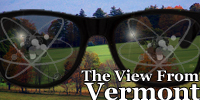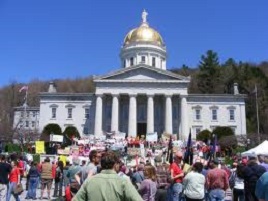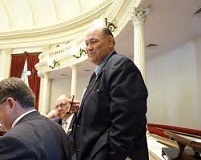Getting inside the legislative process
 The legislative process, at all levels in the United States, is how public policy is created and implemented. These policies affect everyone's life, like it or not. For those concerned about critical issues, and anxious to affect the outcomes, getting inside this process is vital.
The legislative process, at all levels in the United States, is how public policy is created and implemented. These policies affect everyone's life, like it or not. For those concerned about critical issues, and anxious to affect the outcomes, getting inside this process is vital.
Recently, an opportunity arose for me to get inside the process at the state level. How it came about should be helpful to those who want to change policies.
The Vermont legislature and the Vermont Yankee Plant
 The Vermont legislature is solidly Democratic, pro-alternative-energy, and anti-nuclear. Nonetheless, my pro-nuclear professional associates and I have been attending hearings and have been meeting members for years. For example, the Ethan Allen Institute sponsored Gwyneth Cravens, author of Power to Save the World, on a book tour in 2011 that included a lunch time presentation at the Vermont Capital. John McClaughry, vice president of the Institute, used his privilege as a former legislative member to get this presentation scheduled. (Gwyneth's appearance was "for information", not testimony before a concerned committee.)
The Vermont legislature is solidly Democratic, pro-alternative-energy, and anti-nuclear. Nonetheless, my pro-nuclear professional associates and I have been attending hearings and have been meeting members for years. For example, the Ethan Allen Institute sponsored Gwyneth Cravens, author of Power to Save the World, on a book tour in 2011 that included a lunch time presentation at the Vermont Capital. John McClaughry, vice president of the Institute, used his privilege as a former legislative member to get this presentation scheduled. (Gwyneth's appearance was "for information", not testimony before a concerned committee.)
Every week, we review the legislative committee schedules. This past spring we noted that Robert Alvarez, of the Institute for Policy Studies, was to speak to Vermont's House Committee on Natural Resources and Energy. From prior work on a contracted review of his report on the Bush administration's Global Nuclear Energy Partnership plan, I knew Alvarez to be rabidly anti-nuclear. One of his favorite scare tactics is the old "how much radioactive material there is" tactic (stating that a process will contain "x" curies, but never saying why or if this would be a problem, how it might escape, what the effect on people and the environment might be, etc.).
Anti-nuclear testimony
Meredith Angwin and I decided to attend Alvarez's testimony. That morning we met with the state representative for the town of Vernon, which is the Vermont Yankee plant's location. Mike Hebert (R.) is a former U.S. Marine and plant supporter. Many of the plant's employees live in Vernon, and it is doubtful that a plant opponent could be elected from that town.
.
The testimony was as expected; misinformation and scare tactics on used fuel storage. Of course, Alvarez introduced his remarks by saying that they were not about safety, so as not to run afoul of the federal court ruling that the legislature had violated the Nuclear Regulatory Commission's exclusive jurisdiction over reactor safety. At the end of the testimony, Rep. Hebert stated that there was someone present with rebuttal testimony (he meant me). The committee chair said that there was not time allotted for rebuttal that day, but rebuttal would be scheduled for the next week, when Arnie Gundersen was to appear.
Pro-nuclear testimony
The week break, and rescheduling due to the press of legislative business prior to adjournment, allowed for thorough review of Alvarez's testimony and preparation of factual rebuttal. From the chairman's statement, I assumed that I would be sharing an hour of allotted time between my statement and questions with Gundersen. As it turned out, my plan was fortunate. Those testifying on the radiation safety of wireless smart meters ran over their time, and when the chair passed a note to Rep. Hebert asking how much time I needed, I was able to accommodate the committee by saying only 30 minutes.
When the witnesses before me rose to leave, the chairman immediately called me. I passed out copies of my testimony package and began (Testimony below - entire package here). Members followed the written testimony as I read it, and I briefly added remarks.
The first questioner was the committee clerk (third in command). He thanked me for being brief and for having my testimony in language the members could understand, noting that some witnesses attempt to impress the members with technical terms.
The clerk then asked if Vermont Yankee's used fuel would still be there in 300 years. My answer was, "No, it would not. It would be used in new reactors in the U.S., or sold to China or others." Ninety percent of Vermont Yankee's used fuel can be reused.
 There were other questions, and I had opportunity to hold up my tritium self-illuminated EXIT sign (which contains more tritium than was spilled in a widely-publicized pipe system leak at Vermont Yankee years ago-yet, the sign can be ordered through the U.S. mail).
There were other questions, and I had opportunity to hold up my tritium self-illuminated EXIT sign (which contains more tritium than was spilled in a widely-publicized pipe system leak at Vermont Yankee years ago-yet, the sign can be ordered through the U.S. mail).
After the meeting, Rep. Hebert said that he was pleased with my performance.
You can get inside the process
To get inside the process:
- Study your local politics
- Find a member who supports your viewpoint. Party doesn't matter. You don't have to agree on anything else.
- Communicate with that member. Ask them to get you invited to testify. Even minority members have privileges. Majority members know that after the next election, they may be the minority.
- Former members have some privileges too.
We, as citizens, all have the right and duty to participate in the process. If we don't participate, we have no one to blame but ourselves if we don't like the outcome.
Testimony
VERMONT LEGISLATURE
House Natural Resources and Energy Committee
Storage of Used (Spent) Reactor Fuel at the Vermont Yankee Nuclear Power Station
Howard Shaffer, PE (nuclear) VT, NH, MA
Thank you Chairman Klein and Committee Members for allowing me to come before you today. My purpose is to provide what I can from my experience on this important matter. My view is positive.
Virtually my entire career has been in nuclear power. My resume is attached.
BACKGROUND
Missing from the nuclear debate has been clarity about the overall design philosophy of US nuclear generating facilities. From the beginning, every aspect of the program-hardware, training, management, and regulation-has been designed, not on the belief that accidents MIGHT happen, but on the certainty that accidents WILL happen. Experience with human performance proves that there will be mistakes. If the benefits were to be enjoyed, then all possible means to, first, prevent accidents and, second, to deal with the consequences of accidents had to be developed and put in place.
A key part of the design process is asking "What if..?" scenarios for all imaginable events that could happen. The design and licensing process continues and asks "How could this happen?" and "How long does this take to happen?" and "What are the odds that it will happen?" Fast-breaking events require controls that respond instantly and automatically, while longer-term events include actions by trained nuclear operators. For example, the design basis pipe break initiates a series of automatic programmed shutdown responses for the first 10 minutes. At that point, the nuclear operations team takes over the process. The operators are the first responders. At Fukushima, the operators worked diligently until the accident was under control. It took more than a day before there was any release, and the order to evacuate residents in the vicinity came hours before that.
USED (Spent) FUEL STORAGE
One-third of the nuclear fuel in the Vermont Yankee reactor is replaced every 18 months. The fuel that is removed from the reactor and stored on-site continues to be a valuable resource because only about 10 percent of the energy contained in the fuel has been used and 90 percent of that energy can be reclaimed through recycling and used to create more electricity.
The solid ceramic fuel pellets in the fuel bundles that have been removed from the reactor as spent fuel and stored in dry casks are air cooled by natural circulation through the cask. The pellets have been stored in water for more than five years and are generating very little heat. With the shielding in the 100-ton storage casks, the used fuel is very secure. Even if a cask was broken open and the pellets scattered on the ground, they would just lie there, continuing to be air cooled. Radiation dose to the offsite public would be insignificant.
Used fuel in the pool is also very secure. The reactor building and radioactive waste storage facilities are designed for the maximum design basis earthquake and 360 mph winds from a tornado, with 300 mph winds advancing at 60 mph. The fuel pool and the entire cooling system are in those buildings. The system is powered by two redundant emergency backup diesel generators when normal power is lost. There also are backup water supplies to the spent fuel storage pool. Post 9-11 and based on hypothetical spent pool fire studies, the fuel is stored in the pool in a checker-board pattern, with the fuel most recently removed from the reactor, which generates the most heat, surrounded by older fuel (which has been cooling in the pool for up to 35 years) that will absorb heat.
There was an event this February at Pilgrim plant in Massachusetts, a plant like Vermont Yankee. This event illustrates the design margin. During storm Nemo, all offsite power was lost for two days. The reactor scrammed and emergency backup diesels started automatically, as designed. The reactor was brought to cold shutdown by the Pilgrim reactor operations team in 10 hours, and fuel pool cooling, which can be suspended for a long time due to the large volume of water in the pool, was restored after 21 hours!
UNDERSTANDING THE NUCLEAR DEBATE
I've struggled to understand how the debate over nuclear power got to be so politically polarized. Starting with the famous book "Soft Energy Paths," the author wants to do away with nuclear weapons (don't we all?) and he concludes that we must do away with all nuclear power generation-a source of 20 percent of the US electricity supply-in order to do this. This means finding and developing economically-viable technologies to replace the 24/7 base-load power generated by nuclear plants without massive increases in the use of fossil fuels.
Unfortunately, it also has led in some quarters to doing as much as possible to discredit nuclear power. Some supporters of nuclear power call this spreading FUD - Fear Uncertainty and Doubt.
Using examples that increase fear of radiation is a common tactic. For example the warning that an element has a "half-life of millions of years" implies that it will be harmful or dangerous that long. The opposite is true. The longer the half-life, the more slowly the radiation is given off and the lower the dose each year.
Implying that radiation comes only from the generation of electricity with nuclear power and from nuclear weapons is also false. Radiation is natural. The uranium in the granite in this statehouse building was radioactive millions of years ago, and will be radioactive in millions more. This is a natural part of our environment, and we all get low doses of radiation continually.
The sun's light, heat, and other radiation comes from nuclear reactions. We could even say the "Solar Power is Nuclear Power."
Here is an example of a peaceful use of radioactive material. (Hold up EXIT sign.)
Thank you.
Vermont Yankee fuel pool and cooling system design features
- Designed for the safety systems design basis earthquake.
- Located in buildings designed for the design basis earthquake.
- Buildings designed for 360 mph winds (tornado of 300 mph advancing at 60 mph).
- Power can be supplied by the emergency diesels.
- Two 100-percent-capacity cooling pumps, heat exchangers, and filter-demineralizers.
- Cooling water to heat exchangers supplied by safety grade service water.
- Backup water supplies to the pool.
- Pool has a thick stainless steel liner.
- Piping is arranged to prevent siphoning.
- Pool has no drain line.
- Pool liner set in thick reinforced concrete walls and floors.
- Pool is in the middle of the building-not against any outside walls.
- Outside walls around the pool are thick, reinforced concrete.
- Massive steel girders support the reactor building roof, walls, and overhead crane rails.
- These girders and the overhead crane will destroy penetrating aircraft.
- Fuel storage racks have increased capacity for maximum amount of used fuel storage.
_____________________________

Shaffer
Howard Shaffer has been an ANS member for 35 years. He has contributed to ASME and ANS Standards committees, ANS committees, national meeting staffs, and his local section, and was the 2001 ANS Congressional Fellow. He is a current member of the ANS Public Information Committee and consults in nuclear public outreach. He is coordinator for the Vermont Grassroots Project. Shaffer holds a BSEE from Duke University and an MSNE from MIT. He is a regular contributor to the ANS Nuclear Cafe.


